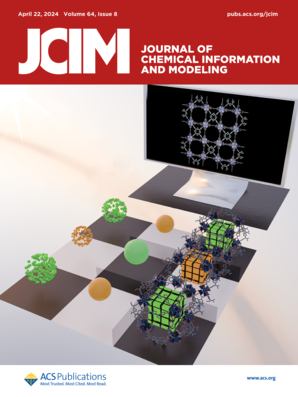真菌角质酶活性裂口的脂肪族聚酯识别和反应性。
IF 5.3
2区 化学
Q1 CHEMISTRY, MEDICINAL
引用次数: 0
摘要
角质酶的蛋白质工程是生物催化降解非天然聚酯的一种很有前途的方法。我们报道了一项机制研究,解决了脂肪族聚酯聚丁二酸丁二醇酯,或PBS)的水解真菌米霉皮化酶。通过原子分子动力学模拟和先进的炼金术转化,我们揭示了模型PBS底物的三个单元如何适应酶的活性位点间隙,与疏水侧链相互作用。底物酯部分接近Asp-His-Ser催化三元组,表现出催化能力强的构象。在量子力学/分子力学DFT(B3LYP)/6-31G**/AMBERff水平上,根据典型酯酶机制模拟了酰化和去酰化水解反应。两个步骤的自由能谱都显示了一个高能四面体中间体,它是由亲核分子攻击酯的羧基碳而产生的。酰化反应的自由能垒(20.2±0.6 kcal mol-1)高于去酰化反应(13.6±0.6 kcal mol-1)。这可能是由于酯的羧基氧与去酰化步骤反应构象中的氧阴离子空穴的相互作用。相反,这些相互作用是在酰化反应过程中形成的。与Ser48侧链相互作用形成额外的氢键对于稳定羧基氧上的显影电荷至关重要,从而降低了激活自由能垒。这些机制的见解将为设计具有改善塑料降解活性的酶变体提供信息。本文章由计算机程序翻译,如有差异,请以英文原文为准。
Aliphatic Polyester Recognition and Reactivity at the Active Cleft of a Fungal Cutinase.
Protein engineering of cutinases is a promising strategy for the biocatalytic degradation of non-natural polyesters. We report a mechanistic study addressing the hydrolysis of the aliphatic polyester poly(butylene succinate, or PBS) by the fungal Apergillus oryzae cutinase enzyme. Through atomistic molecular dynamics simulations and advanced alchemical transformations, we reveal how three units of a model PBS substrate fit the active site cleft of the enzyme, interacting with hydrophobic side chains. The substrate ester moiety approaches the Asp-His-Ser catalytic triad, displaying catalytically competent conformations. Acylation and deacylation hydrolytic reactions were modeled according to a canonical esterase mechanism using umbrella sampling simulations at the quantum mechanical/molecular mechanical DFT(B3LYP)/6-31G**/AMBERff level. The free energy profiles of both steps show a high-energy tetrahedral intermediate resulting from the nucleophilic attack on the ester's carboxylic carbon. The free energy barrier of the acylation step is higher (20.2 ± 0.6 kcal mol-1) than that of the deacylation step (13.6 ± 0.6 kcal mol-1). This is likely due to the interaction of the ester's carboxylic oxygen with the oxyanion hole in the reactive conformation of the deacylation step. In contrast, these interactions form as the reaction proceeds during the acylation step. The formation of an additional hydrogen bond interaction with the side chain of Ser48 is crucial to stabilizing the developing charge at the carboxylic oxygen, thus lowering the activation free energy barrier. These mechanistic insights will inform the design of enzyme variants with improved activity for plastic degradation.
求助全文
通过发布文献求助,成功后即可免费获取论文全文。
去求助
来源期刊
CiteScore
9.80
自引率
10.70%
发文量
529
审稿时长
1.4 months
期刊介绍:
The Journal of Chemical Information and Modeling publishes papers reporting new methodology and/or important applications in the fields of chemical informatics and molecular modeling. Specific topics include the representation and computer-based searching of chemical databases, molecular modeling, computer-aided molecular design of new materials, catalysts, or ligands, development of new computational methods or efficient algorithms for chemical software, and biopharmaceutical chemistry including analyses of biological activity and other issues related to drug discovery.
Astute chemists, computer scientists, and information specialists look to this monthly’s insightful research studies, programming innovations, and software reviews to keep current with advances in this integral, multidisciplinary field.
As a subscriber you’ll stay abreast of database search systems, use of graph theory in chemical problems, substructure search systems, pattern recognition and clustering, analysis of chemical and physical data, molecular modeling, graphics and natural language interfaces, bibliometric and citation analysis, and synthesis design and reactions databases.

 求助内容:
求助内容: 应助结果提醒方式:
应助结果提醒方式:


